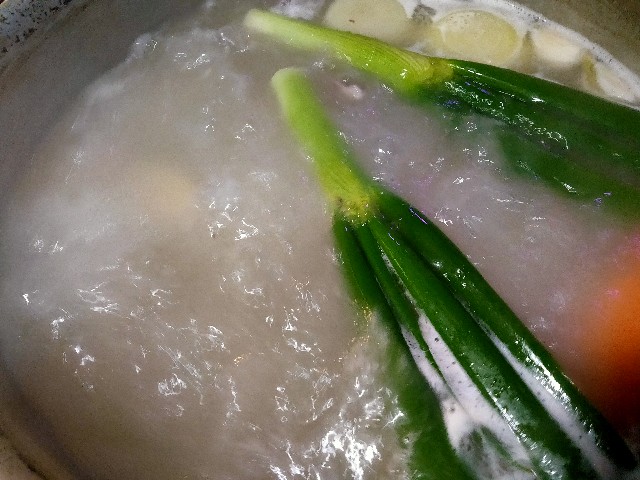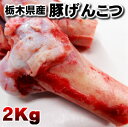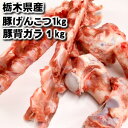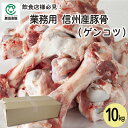It's been a while since I made pork bone ramen.
I got 5kg of pork femur, also known as "genkotsu" in pork bones. I wash it well with water using a new scrub brush. I put water in a large pot, blanch it for about an hour, and then wash it again.It gradually becomes cloudy.



To be continued.
[rakuten:kumamoto-food:10002744:detail]
[rakuten:sumiyoshi:10002062:detail]
鹿児島 (Kagoshima): A city in Kyushu, Japan, known for its active volcano, Sakurajima.
ラーメン (Ramen): A popular noodle soup dish in Japan.
風 (Fū): Means "style" or "like", used to describe the style of something.
とんこつ (Tonkotsu): Refers to a type of ramen broth made from pork bones.
しょうゆ (Shōyu): Soy sauce in Japanese.
作り方 (Tsukurikata): Means "how to make" or "method of making".
豚骨 (Butabone): Pork bones, often used in making broths for ramen.
下茹で (Shitayude): Blanching, a cooking process.
煮込む (Nikomu): To simmer or stew.
久しぶり (Hisashiburi): Means "it's been a while".
げんこつ (Genkotsu): The knuckle or joint part of an animal, often used in cooking.
大腿骨 (Daitaikotsu): Femur, the thigh bone of an animal.
たわし (Tawashi): A scrubbing brush in Japan, often used for cleaning.
寸胴 (Sundō): A large cooking pot.
洗う (Arau): To wash or clean.
強火 (Kyōka): High heat, used in cooking instructions.
沸騰 (Futtō): Boiling or to boil.
人参 (Ninjin): Carrot, a root vegetable.
玉ねぎ (Tamanegi): Onion, a vegetable used in many dishes.
透明 (Tōmei): Transparent or clear.
スープ (Sūpu): Soup, a liquid dish.
濁る (Nigoru): To become cloudy or muddy.
次回 (Jikai): Next time or next episode.
続く (Tsuzuku): To continue or to be continued.
ブログ (Burogu): Blog, a regularly updated website or web page.
北海道 (Hokkaido): The second largest island of Japan.
放牧 (Hōboku): Free-range, a method of farming.
自家製 (Jikasei): Homemade or homegrown.
ボーンブロス (Bōn burosu): Bone broth, a nutritious liquid made from boiling the bones of animals.
豚背骨 (Butasebone): Pork spine, a part of the pig often used in cooking.
冷凍 (Reitō): Frozen, preserved by freezing.
お肉屋さん (Onikuyasan): Butcher, a person who prepares and sells meat.
無添加 (Muttenka): Additive-free, without added artificial substances.
白湯 (Paitan): White soup, a type of broth made from boiling bones for a long period.
明星 (Myōjō): A popular brand of instant noodles in Japan.
チャルメラ (Charumera): A type of ramen, named after the musical instrument used by street vendors.
バリカタ (Barikata): Hard, often used to describe the firmness of ramen noodles.
麺 (Men): Noodles, a staple food in many cultures made from unleavened dough.
食パック (Shokupakku): Meal pack, a pre-packaged meal.
ノーブランド品 (Nōburandohin): No-brand product, a product without a brand name.
アマゾン (Amazon): Amazon, an American multinational technology company.
ラクテン (Rakuten): Rakuten, a Japanese electronic commerce and online retailing company.
単語解説
Making (Verb): 作ること。何かを生み出す行為。
Style (Noun): スタイル、様式。特定の方法や形式を指す。
Soy (Noun): 大豆。食品や調味料の製造に使われる。
Sauce (Noun): ソース。食品の風味を引き立てるための液体。
Ramen (Noun): ラーメン。日本の人気のある麺料理。
Pork (Noun): 豚肉。豚から得られる肉。
Bones (Noun): 骨。動物の体を支える硬い組織。
Boil (Verb): 沸騰させる。液体をその沸点まで加熱する。
Simmer (Verb): 煮込む。液体を沸騰点よりも低い温度でゆっくりと加熱する。
Femur (Noun): 大腿骨。人間や動物の脚の一部。
Scrub (Verb): こする。固くこすりつけて清掃する。
Brush (Noun): ブラシ。清掃や塗装に使用される道具。
Pot (Noun): 鍋。料理に使用される容器。
Heat (Verb): 加熱する。熱を加えること。
Carrots (Noun): ニンジン。食用の根菜。
Onions (Noun): タマネギ。料理によく使われる野菜。
Soup (Noun): スープ。主に液体から成る料理。
Clear (Adjective): 透明な。光を通すことができる。
Cloudy (Adjective): 濁った。透明度が低い。
Continue (Verb): 続ける。何かを止めずに行う。
文法解説
Present Participle (Making): 現在分詞。"-ing"で終わる動詞の形。例:"Making Kagoshima-style Tonkotsu Soy Sauce Ramen for the first time."(初めて鹿児島風とんこつしょうゆラーメンを作る)
Prepositions (for): 前置詞。他の単語との関係を示す。例:"for the first time"(初めて)
Nouns (Kagoshima-style, Tonkotsu, Soy Sauce, Ramen): 名詞。人、場所、物、アイデアを表す。例:"Kagoshima-style Tonkotsu Soy Sauce Ramen"(鹿児島風とんこつしょうゆラーメン)
Past Simple (got): 過去形。過去の出来事を表す。例:"I got 5kg of pork femur"(私は豚の大腿骨を5kg手に入れた)
Past Participle (used): 過去分詞。完了形や受動形を作るために使われる。例:"I wash it well with water using a new scrub brush."(新しいたわしを使って水でよく洗う)
Adverbs (well): 副詞。動詞、形容詞、他の副詞を修飾する。例:"I wash it well with water"(水でよく洗う)
Conjunctions (and): 接続詞。文や文の部分をつなげる。例:"I put water in a large pot, blanch it for about an hour, and then wash it again."(大きな鍋に水を入れ、約1時間茹で、そして再度洗う)
Future Simple (will): 未来形。未来の出来事を表す。例:"Let me know when you want me to continue with the explanation of other words."(他の単語の説明を続けてほしいときは教えてください)
Modal Verbs (can): モーダル動詞。能力、可能性、許可、義務などを表す。例:"Let me know when you want me to continue with the explanation of other words."(他の単語の説明を続けてほしいときは教えてください)
Infinitive (to continue): 不定詞。動詞の基本形。例:"Let me know when you want me to continue with the explanation of other words."(他の単語の説明を続けてほしいときは教えてください)
Present Perfect (has been): 現在完了形。過去の出来事と現在の状況をつなげる。例:"It's been a while since I made pork bone ramen."(豚骨ラーメンを作ってから久しぶりだ)
Present Continuous (am washing): 現在進行形。現在進行中の行動を表す。例:"I am washing it well with water using a new scrub brush."(新しいたわしを使って水でよく洗っています)
Adjectives (new): 形容詞。名詞を修飾する。例:"using a new scrub brush"(新しいたわしを使って)
Quantifiers (5kg): 量詞。数量を表す。例:"I got 5kg of pork femur"(豚の大腿骨を5kg手に入れた)
Comparatives (more): 比較級。二つのものを比較する。例:"Let me know when you want me to continue with the explanation of other words."(他の単語の説明を続けてほしいときは教えてください)
Superlatives (most): 最上級。三つ以上のものを比較する。例:"This is the most delicious ramen I've ever had."(これは今まで食べたラーメンの中で最も美味しい)
Imperatives (Let): 命令形。命令や要求を表す。例:"Let me know when you want me to continue with the explanation of other words."(他の単語の説明を続けてほしいときは教えてください)
Conditionals (if): 条件形。ある条件が満たされたときの結果を表す。例:"If you need more explanations, let me know."(もしもっと説明が必要なら、教えてください)
Passive Voice (is made): 受動態。行為の受け手を強調する。例:"The ramen is made with pork bones."(ラーメンは豚骨で作られています)
Gerunds (cooking): ジェランド。"-ing"で終わる名詞の形。例:"Cooking is my hobby."(料理は私の趣味です)






